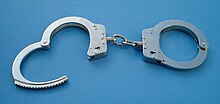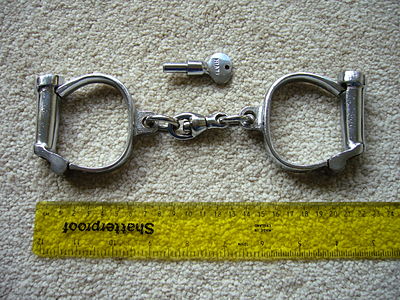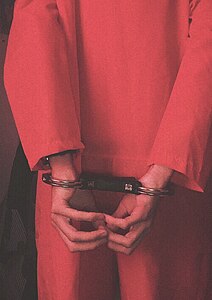
Bondage, in the BDSM subculture, is the practice of consensually tying, binding, or restraining a partner for erotic, aesthetic, or somatosensory stimulation. A partner may be physically restrained in a variety of ways, including the use of rope, cuffs, bondage tape, or self-adhering bandage.

Physical restraint refers to means of purposely limiting or obstructing the freedom of a person's bodily movement.
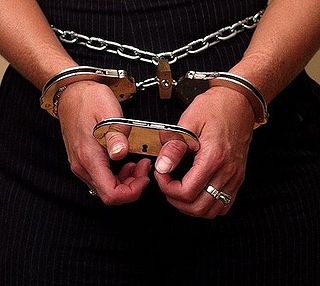
Thumbcuffs are a metal restraining device that lock thumbs in proximity to each other.

A hinge is a mechanical bearing that connects two solid objects, typically allowing only a limited angle of rotation between them. Two objects connected by an ideal hinge rotate relative to each other about a fixed axis of rotation, with all other translations or rotations prevented; thus a hinge has one degree of freedom. Hinges may be made of flexible material or moving components. In biology, many joints function as hinges, such as the elbow joint.

Bondage cuffs are restraints designed for use in sexual bondage situations. Compared to conventional handcuffs, they are wide wrist and ankle restraints generally made of leather, often padded with soft leather or fake fur. Bondage cuffs may be fastened at the wrists and/or ankles by a locking mechanism, by a buckle or by velcro. They are secured around the wrist or ankle, and the cuffs may then be attached to each other or another object.
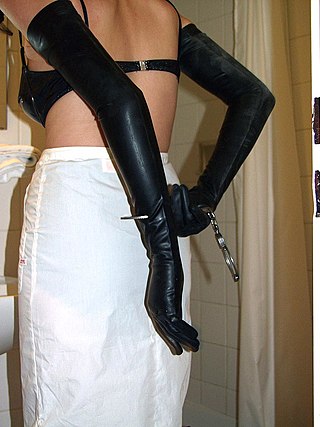
Self-bondage refers to the use of restraints on oneself for erotic pleasure. It is a form of erotic bondage which can be practiced alone.

Legcuffs are physical restraints used on the ankles of a person to allow walking only with a restricted stride and to prevent running and effective physical resistance. Frequently used alternative terms are leg cuffs, (leg/ankle) shackles, footcuffs, fetters or leg irons. The term "fetter" shares a root with the word "foot".

Cufflinks are items of jewelry that are used to secure the cuffs of dress shirts. Cufflinks can be manufactured from a variety of different materials, such as glass, stone, leather, metal, precious metal or combinations of these. Securing of the cufflinks is usually achieved via toggles or reverses based on the design of the front section, which can be folded into position. There are also variants with chains or a rigid, bent rear section. The front sections of the cufflinks can be decorated with gemstones, inlays, inset material or enamel and designed in two or three-dimensional forms.

Plastic handcuffs are a form of physical restraint for the hands made of plastic straps. They function as handcuffs but are cheaper and easier to carry than metal handcuffs, and they cannot be reused. The device was first introduced in 1965.

A body belt is any waist belt which has D-rings or other attachment points. The belts can be used as medical restraints in institutions for bed and wheelchair restraints, and for safety in activities such as abseiling or construction work. When they are used in sexual bondage plays they are commonly referred to as bondage belts, and also worn in fetish clothing. The belts are usually fastened with buckles and some by a locking mechanism, which enables quick release.

A cuff is a layer of fabric at the lower edge of the sleeve of a garment at the wrist, or at the ankle end of a trouser leg. The function of turned-back cuffs is to protect the cloth of the garment from fraying, and, when frayed, to allow the cuffs to be readily repaired or replaced, without changing the garment. Cuffs are made by turning back (folding) the material, or a separate band of material can be sewn on, or worn separately, attached either by buttons or studs. A cuff may display an ornamental border or have lace or some other trimming. In US usage, the word trouser cuffs refers to the folded, finished bottoms of the legs of a pair of trousers. In the UK, while this usage is now sometimes followed, the traditional term for the turned up trouser hem is 'turnup'.
Thomas Solomon is an American escape artist and magician.

Speedcuffs are a model of handcuff characterised by their rigid grip between the two ratchet cuffs. Their rigid design and the inclusion of a grip makes them effective for gaining control over a struggling prisoner, even if only one cuff has been applied. They are standard issue for most police forces within the United Kingdom.

A chain is a serial assembly of connected pieces, called links, typically made of metal, with an overall character similar to that of a rope in that it is flexible and curved in compression but linear, rigid, and load-bearing in tension. A chain may consist of two or more links. Chains can be classified by their design, which can be dictated by their use:

Prisoner transport is the transportation of prisoners by law enforcement agencies or contractors.

A police duty belt is a belt, typically constructed of nylon or leather used by police, prison and security officers to carry equipment easily in a series of pouches attached to the belt, in a readily-accessible manner, while leaving the hands free to interact. This belt can carry any number of useful items, ranging from handcuffs to guns.

A door chain, security chain, or security door chain or chain door interviewer consists of a small chain attached to the door frame, which attaches to a track on the door for security purposes. It is a type of lock that is often used along with other types of locks to secure a door. They are commonly used on hotel and motel room doors.
A belly chain is a physical restraint worn by prisoners, consisting of a chain around the waist, to which the prisoner's hands may be chained or cuffed. Sometimes the ankles are also connected by means of longer chains.
Roslyn Walker is an entertainer. He currently resides in Conwy with his partner, dancer Foxee Stole.

A handcuff cover is a plastic or metal cover that can be placed over a pair of handcuffs. It consists of a hinged, box-like assembly locked over the handcuff chain, wristlets and keyholes.
